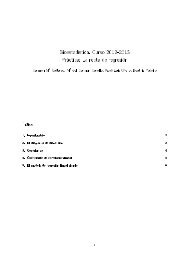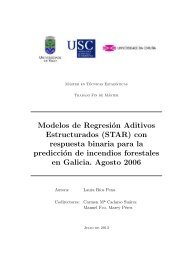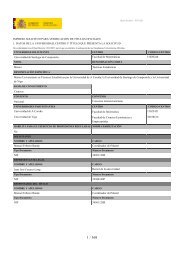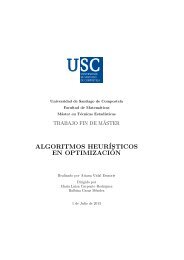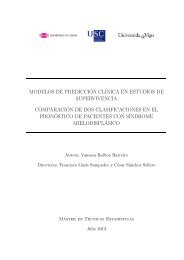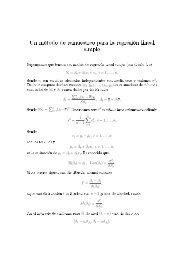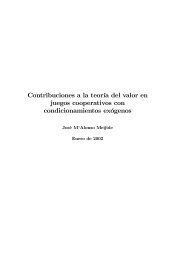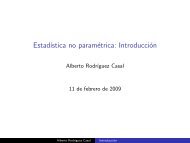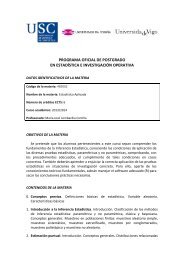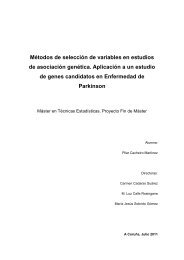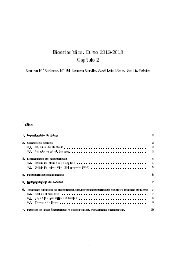Bootstrap independence test for functional linear models
Bootstrap independence test for functional linear models
Bootstrap independence test for functional linear models
Create successful ePaper yourself
Turn your PDF publications into a flip-book with our unique Google optimized e-Paper software.
One asymptotic distribution free based on the latter approach was given by Cardot, Ferraty, Mas,and Sarda (2003). They proposed as <strong>test</strong> statisticT 1,n = kn(ˆσ −1/2 −2 || √ )n∆ n  n || 2 − k n , (8)where Ân(·) = ∑ k n ˆλ−1/2j=1 j〈·, ˆv j 〉ˆv j and ˆσ 2 is a consistent estimator of σ 2 . Cardot, Ferraty, Mas, andSarda (2003) showed that, under H 0 , T 1,n converges in distribution to a centered Gaussian variablewith variance equal to 2. Hence, H 0 is rejected if |T 1,n | > √ 2z α (z α the α–quantile of a N (0, 1)),and accepted otherwise. Besides, Cardot, Ferraty, Mas, and Sarda (2003) also proposed anothercalibration of the statistic distribution based on a permutation mechanism.On the other hand, taking into account that ||Θ|| 2 = ∑ ∞j=1 (∆(v j)/λ j ) 2 , one can use the statisticwhich limit distribution is not known.T 2,n =k n ∑j=1(∆ n (ˆv j )ˆλ j) 2, (9)Finally, a natural competitive statistic is the one proposed throughout Section 2.3∥ 1n∑∥∥∥∥T 3,n =(X i −∥n¯X)(Y i − Ȳ ) , (10)i=1which we will denote by “F–<strong>test</strong>” from now on since it is the natural generalization of the well–known F–<strong>test</strong> in the finite–dimensional context. Another possibility is to consider the studentizedversion of (10)∥T 3s,n = 1ˆσ1n∑∥∥∥∥ (X i −∥n¯X)(Y i − Ȳ ) , (11)where ˆσ 2 is the empirical estimation of σ 2 .i=1In general, <strong>for</strong> the statistics such as (8), (9), (10) and (11), the calibration of the distributioncan be obtained by using bootstrap. Furthermore, in the previous section, “naive” and “wild”bootstrap were shown to be consistent <strong>for</strong> the F–<strong>test</strong>, that is, the distribution of T 3,n and T 3s,ncan be approximated by their corresponding bootstrap distribution, and H 0 can be rejected whenthe statistic value does not belong to the interval defined <strong>for</strong> the bootstrap acceptation region ofconfidence 1 − α. The same calibration bootstrap can be applied to the <strong>test</strong>s based on T 1,n andT 2,n , although the consistence of the bootstrap procedure in this cases have not been proved in thiswork.4 Simulation and real data applicationsIn this section a simulation study and an application to a real dataset illustrate the per<strong>for</strong>mance ofthe asymptotic approach and the bootstrap calibration from a practical point of view.4.1 Simulation studyWe have simulated ns = 500 samples, each being composed of n ∈ {50, 100} observations fromthe <strong>functional</strong> <strong>linear</strong> model Y = 〈Θ, X〉 + ε, being X a Brownian motion and ε ∼ N (0, σ 2 ) withsignal–to–noise ratio r = σ/ √ E(〈X, Θ〉 2 ) ∈ {0.5, 1, 2}.11



